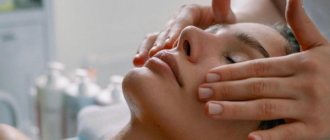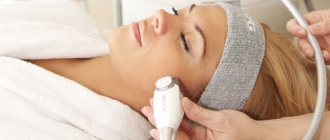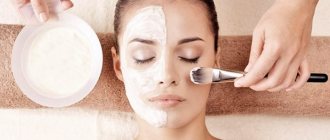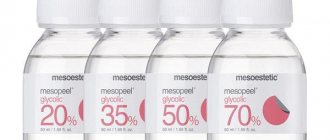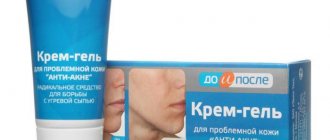In this article we discuss glycolic peeling. We will tell you what it is, indications for the procedure, and whether it can be performed during pregnancy. You will find out whether it is possible or not to peel with glycolic acid in the summer, whether it is possible to carry out the procedure at home or only in the salon, the necessary care, contraindications, consequences and results.
What is a glycolic peel?
Glycolic peeling is a type of chemical peeling that is based on the action of glycolic (hydroxyacetic) acid. In the past, it was made from raw materials based on sugar cane; nowadays, chemicals are most often used. When it comes into contact with the skin, it affects the upper layers of the epidermis.
Under the influence of glycolic acid, the production of fibroblasts and its own collagen is stimulated, cell metabolism improves, old skin cells die off, and are replaced by young and elastic ones.
Peeling with glycolic acid improves the quality of the dermis, restores skin tone and turgor, refreshes and slightly whitens the face. The procedure gives an amazing effect; after just 5 procedures, patients look 5 years younger, the processes of skin aging and the formation of wrinkles slow down.
Glycolic acid is gentle on the skin, but this does not interfere with achieving the desired result. To obtain the best effect, it is recommended to carry out exfoliation courses.
History of glycolic peeling
The first mentions of the use of glycolic peeling are found in Ancient Egypt. At that time, sugar cane juice was used to improve the condition of the skin, cleanse it and prevent early aging. This acid is also present in beets and unripe grapes.
In the 70s of the 20th century, they first learned about glycolic acid. During research, scientists learned that the molecules of this acid actively influence keratinized layers, weaken the bonds between dead cells and accelerate the formation of new collagen molecules.
In 1996, glycolic acid concentrate was tested on human skin for the first time. The result was the identification of the principle of action of glycolic acid. The testing involved 41 patients of different ages and with various skin problems. The essence of the experiment was the systematic exposure of the skin to a chemical substance. Once every 7 days, the patient’s hand and half of the face were treated with a 50% glycolic acid solution.
After 4 weeks, scientists identified noticeable changes in the condition of the skin. There was an increase in active living cells of the epidermis, a decrease in horny layers and photosensitivity of the skin. At the same time, small wrinkles completely disappeared. A similar result was observed in 90% of patients, which subsequently gave impetus to the use of glycolic acid in beauty salons.
Photos before and after procedures
In many salons where they do glycolic peeling, photos with the results can be seen right in the lobby. The results are truly amazing and often even a minimal course allows you to get radical changes in your facial skin. However, glycolic acid should not be considered an absolutely safe product. If applied incorrectly or choose the wrong intensity of exposure to the skin, you may encounter unpleasant consequences. From redness and itching to swelling that lasts for several days.
It is also important to remember that photos in salons show the results of the entire course, which can include up to 10 visits. The effect may differ 2-3 times, although glycolic acid is one of the most effective chemicals in terms of effectiveness.
Indications for the procedure
Glycolic peeling can be performed at any age, but not younger than 15 years. Indications for the procedure are:
- dryness and flaking of the skin;
- the presence of scars and scars after squeezing out pimples (also find out how to remove marks after pimples);
- rosacea;
- a large number of freckles or their large size;
- unhealthy skin color and unnaturally strong redness;
- stretch marks;
- hyperkeratosis;
- decreased turgor and skin tone;
- early signs of skin aging;
- oily skin - glycolic acid has a positive effect on the functioning of the sebaceous glands, normalizing it;
- small wrinkles.
Where can I buy
Glycolic facial peeling does not require long-term rehabilitation; the process of restoring the integrity of the skin proceeds calmly, without complications or allergic reactions. Therefore, girls often resort to cleansing procedures at home.
For home cleansing, you need to purchase special kits containing glycolic acid. They are sold in pharmacies and specialized professional cosmetics stores. It is not recommended to buy acid peeling products on the Internet, unless these are the official websites of the product manufacturer.
The professional glycolic peeling kit includes:
- a scrub based on fruit acids or another product for pre-peeling cleansing and skin preparation;
- gel peeling with a concentration of glycolic acid of 15–50%;
- acid neutralizer.
Such sets may additionally include soothing and moisturizing masks, makeup remover, application brush, day and night care creams. Accordingly, the cost of such a kit increases.
Attention! Cosmetologists strongly do not recommend performing acid treatments on your own. Acid with a concentration of 10% corrodes rust, imagine what can happen to the skin if the chemical is used inappropriately.
Properties of glycolic acid and how it is beneficial for the skin
Hydroxyacetic acid has a beneficial effect on rejuvenating and cleansing the dermis due to the following properties:
- Rejuvenating - the acid penetrates into the skin, activating the synthesis of collagen and fibroblasts. As a result, the turgor of the dermis increases, the skin texture is evened out, fine wrinkles disappear, and medium and deep “crow’s feet” become almost invisible.
- Cleansing - hydroxyacetic acid molecules penetrate into the deepest layers of the epidermis, thereby eliminating dead and dead skin cells.
- Moisturizing - after using glycolic acid, the skin of the face becomes soft and moisturized. This substance stabilizes the pH balance of the skin, increases metabolic processes and the activity of the sebaceous glands, thereby improving the condition of the skin.
- Providing a lifting effect - hydroxyacetic acid helps increase the elasticity of soft tissues, smoothes the relief and reduces deep wrinkles.
- Anti-inflammatory - glycolic peeling is used for medicinal purposes to eliminate pimples and acne. The exfoliant prevents the development of cosmetic problems, reduces inflammatory processes, due to which infected areas on the face disappear.
The main features of glycolic acid are ease of penetration and effectiveness. In a short time, you can get rid of hated acne, freckles and age spots, and you will also look younger!
Glycolic acid extremely rarely causes allergies in patients. Thanks to this, chemical peeling is suitable for almost any woman who dreams of becoming more beautiful.
Types of glycolic peeling
There are several types of glycolic acid peels. Their main difference is the percentage of the main substance. Below we will look in detail at the advantages and disadvantages of each type so that you can choose the best one for your situation.
Superficial peeling
The concentration of glycolic acid is no more than 40%, the pH level ranges from 2.4-4.5. Superficial glycolic peeling affects the upper layers of the skin and also has an exfoliating effect.
After the procedure, the skin texture becomes smoother, age spots disappear, the complexion is evened out, and a healthy glow appears. Glycolic peeling 25% is indicated for use at a young age to correct minor skin problems and to eliminate increased oiliness.
Medium peeling
The concentration of glycol substance is up to 70%. Glycolic peeling 50-70% is used to eliminate age-related changes in the dermis. The procedure is recommended for people over 35 years of age.
Exfoliation helps to cope with residual marks from acne and acne, activates regeneration processes and smoothes the skin texture.
Deep peeling
The deepest and most effective type of chemical treatment is considered to be 70% peeling with glycolic acid. It activates neocollagenesis in the deep layers of the epidermis and removes dead particles.
The disadvantages of such peeling include pain, peeling of the skin after the procedure, as well as the appearance of a crust on the face and the formation of erythema.
Indications for use of peeling
Peeling can be used by women of any skin type. It is suitable for girls with fair skin, with freckles, and dark-skinned women with less vulnerable skin.
Acid has varying degrees of concentration. With a gentle action, the top layer of skin is affected. Sometimes a medium peel should be carried out, penetrating even deeper into the skin.
For clients aged 35-45 years, peeling eliminates fine wrinkles. Patients over 50 years of age should choose a type of peeling with a stronger effect. The method will fix the problems:
- scarring;
- stretch marks;
- wrinkles;
- freckles.
Glycolic peeling at home
If you do not have the opportunity to perform a glycolic acid peel in a beauty salon, then you can do it at home. In this case, use a minimum acid concentration of 10%.
Many cosmetics manufacturers offer a wide range of products with glycolic acid, for example, Belita or Mary Kay. Buy products only with a good expiration date, and during the procedure strictly follow the instructions for use. Only in this case will you be able to achieve amazing results.
Peeling with 10% glycolic acid will return a healthy glow and refresh the skin, get rid of comedones and clogged pores, and slightly even out the texture and post-acne. Home peeling will not be able to cope with crow’s feet, deep acne marks and other serious problems.
Regardless of what concentration of hydroxyacetic acid you use, a full course of procedures is necessary. This helps to consolidate and enhance the result obtained. It is also important to adhere to certain rules after peeling (we will talk about them later), since failure to comply with them can lead to negative consequences.
Preparation and stages
To obtain the best results from using glycolic acid for facial skin care, you must follow a strict sequence of actions. Failure to comply with them can lead to negative consequences when your face after the procedure will look much worse than before it.
Facial peeling with glycolic acid consists of 3 stages:
- Preparation;
- peeling;
- recovery period.
Let's take a closer look at each of the stages.
Preparation
Preparation is an important step in the facial cleansing procedure. It involves gradually adding a small amount of hydroxyacetic acid to the skin care cosmetics used.
It is necessary to begin preparing the skin 7-10 days before the procedure. Add 5-10% glycolic acid to your daily skin care products. Please note that the pH level of such cosmetics should be within 3-5.
The use of such cosmetics normalizes the water-alkaline balance of the skin, softens it and adapts it to the chemical substance.
Cosmetologists have developed a scheme for using products with glycolic acid in the preparatory period, depending on skin type:
- Oily and combination skin - apply cosmetics with acid once a day for a week. From day 8, apply the product twice a day (morning and evening).
- Dry - use cosmetics with acid once a day during the entire preparatory period.
- Normal - apply the product twice a day (morning and evening). If your skin becomes dry, reduce the use of cosmetics with acid to 1 time.
2 days before cleansing your face, apply a small amount of glycolic acid to the crook of your elbow. If you notice peeling, redness, or itching, it is recommended to refuse the procedure. It is best to replace hydroxyacetic acid peeling with almond or lactic acid peeling, or abandon the procedure altogether. You will also need to consult a cosmetologist.
How does peeling work?
The procedure for chemical facial cleansing is as follows:
- Makeup and impurities are removed from the face using cleansing milk, gel or lotion.
- After this comes the turn of degreasing. Fat particles hold glycolic acid molecules on the surface, preventing it from penetrating into the deeper layers of the epidermis. Because of this, you may not expect any special effect from the procedure. Therefore, the cosmetologist wipes the patient’s face with a degreasing lotion, paying special attention to the ducts of the sebaceous glands.
- The cosmetologist pours a certain amount of glycolic acid into a separate container. After this, use 2 cotton swabs to distribute it on the surface of the facial skin. This is done quickly to ensure uniform penetration of the composition deep into the dermis. Additionally, a light massage is performed.
- To reduce pain, a stream of cold air is directed onto the face.
- After 2-5 minutes, depending on the selected percentage of acid and the pH level of the solution, the cosmetologist neutralizes the acidic product. Typically, saline solution is used for these purposes. It stops the action of acid and stabilizes the water-salt balance. If the patient does not feel a burning sensation or other discomfort, this means complete neutralization of the acidic substance.
- To calm the dermis after the procedure, a special mask is applied to the face. After 5 minutes, it is washed off, and a nourishing and sunscreen is applied to the skin.
After glycolic peeling in the salon, a rehabilitation period begins at home. It depends on it how easily and quickly the skin is restored, as well as the final effect of chemical exposure.
Recovery period
Rehabilitation after chemical peeling lasts a week (in case of normal skin renewal). During this period, the dermis will regenerate, peeling and redness, which often occur during peeling, will disappear.
Advice from cosmetologists during rehabilitation:
- during the first 5 days after the procedure, use sunscreen to prevent the formation of excessive pigmentation;
- try to spend less time in the sun, don’t go outside
- avoid visiting saunas, solariums and baths;
- For 7 days, use cosmetics prescribed by a cosmetologist. They help restore skin faster;
- do not engage in sports, as physical activity increases body temperature and a rush of blood to the face;
- After the procedure, the skin will actively peel off and dead tissue will hang down. Do not tear them off; trim them with scissors if necessary.
The more correctly you follow the above tips, the faster and more effective the recovery process will be. At the slightest deviation, immediately consult a cosmetologist.
Varieties
There are several types of peeling technique using hydroxyacetic acid . Each procedure differs from each other in the percentage of the active substance. Let's look at the main options.
Surface
To carry out superficial exfoliation, concentrated glycolic acid is used up to 40%, where the pH value corresponds to a level of 2.4–4.5. The main effect of the technique is the rejection of the keratinized layer of the epidermis.
According to experts, this type of peeling is suitable for young women , for example, if you want to even out the tone or texture of the skin, or normalize the functioning of the sebaceous glands. After several procedures, the skin will become fresh and smooth. To some extent, this is an “ambulance” before an important event.
We recommend: What to do with problematic facial skin? Which peeling is better to choose?
Deep
This type of peeling is more aggressive and deeper, since the composition contains a high concentration of the main active ingredient - glycolic acid. The drug penetrates deeply into the layers of the dermis, so an active response can be observed. It could be:
- skin redness;
- formation of a brownish crust;
- peeling.
Main components:
- hydroxyacetic acid - with a concentration of up to 70 percent;
- the pH level should not be lower than 2.8 (a low indicator indicates the severity of acidic properties).
Due to the listed indicators, a procedure with a 70 percent acid composition can be painful .
Do not be afraid of such peeling; local anesthesia may be used during the procedure. As a result, girls get more pronounced results.
The technique is suitable for any skin type and age category. An experienced specialist must take an individual approach to each client, taking into account skin type and concomitant somatic diseases.
How often can you do a glycolic peel?
Only a cosmetologist can tell you how many chemical peeling procedures you will need. It all depends on the condition of the skin, the age of the patient and the desired result. For some, 1 session is enough to see changes in their appearance, while for others, 10 procedures are not enough to be satisfied with the results.
The average peeling course is 5 sessions, after which the result is clearly visible. In this case, the full course can reach up to 10 procedures.
Each new peeling is carried out only after complete restoration of the skin (1-1.5 weeks). When using a medium glycolic peel, the interval between sessions is 90 days.
A cosmetologist can determine whether the next peeling can be performed based on the condition of the skin. The result of the procedure depends on his professionalism. For this reason, it is recommended to carefully choose a beauty salon and specialist.
Advantages and disadvantages
Chemical peeling is a popular type of cosmetic procedure for cleansing and rejuvenating the skin. A pronounced effect and an affordable price are its main advantages.
Among the advantages of glycolic peeling it is also worth highlighting:
- soft and deep cleansing;
- versatility - suitable for dry, combination, oily, problem skin at any age;
- does not require anesthesia;
- characterized by an easy course of rehabilitation, rarely accompanied by complications;
- can be performed at home.
There are also disadvantages:
- restoration of the integument will take some time, special care will be required;
- ineffective against deep wrinkles, tissue ptosis;
- a single procedure will not provide the desired, long-term result; a course of peelings will be required;
- there is a risk of complications if exfoliation is performed incorrectly;
- has contraindications.
Consequences
Peeling with glycolic acid is one of the safest chemical facial cleansers. But even this procedure may have negative consequences, including:
- 1st or 2nd degree burn - occurs as a result of incorrectly selecting the acid concentration or increasing the duration of the procedure. If you feel severe discomfort and pain, neutralize the acid, apply burn cream and consult a doctor. New peeling procedures can only be performed after the dermis has completely healed.
- Hyperpigmentation - it occurs as a result of high photosensitivity of the skin or due to improper behavior during the rehabilitation period. Before the procedure, be sure to read the contraindications and recommendations of cosmetologists on how to behave after peeling. This will help prevent the formation of age spots.
- An allergic reaction occurs due to improper peeling technology. Before the procedure, be sure to perform an allergy test. If you notice signs of swelling and difficulty breathing, call a doctor immediately. If the reaction is mild, then neutralize the effect of the acid and go to the doctor.
- Increased dryness of the skin - in this case, you need to contact a cosmetologist to prescribe moisturizers.
Contraindications
In some cases, chemical peeling with glycolic acid is not recommended. Contraindications are:
- inflammatory processes in the treated areas of the skin;
- individual intolerance to the drug and its constituent substances;
- wounds, abrasions and scratches on the face;
- acute form of herpes;
- chronic diseases;
- high photosensitivity of the skin;
- warts on the face and other neoplasms on the skin;
- fresh tan;
- Mongoloid or Negroid skin type - in this case, peeling can cause hyperpigmentation; the treated and untouched areas of the skin on the face will differ;
- taking retinoids (vitamin A and its derivatives) - retinol increases the effect of chemical exposure, which can negatively affect sensitive skin;
- eyebrow correction and hair removal in the recent past (small wounds may occur in the treatment area).
Precautionary measures
The absence of contraindications is one of the main conditions for performing the procedure. Neglecting them will affect the condition of the skin, can lead to complications and will only worsen health problems. Reasons for refusing to use a glycolic agent may include:
- rosacea, rosacea on the face;
- fresh tan;
- allergy to acid or auxiliary components of the selected product;
- skin inflammation, dermatitis, herpes;
- wounds, scratches and other violations of the integrity of the integument on the face;
- pregnancy;
- lactation;
- papillomas, moles, warts in the treatment area;
- oncology, diabetes mellitus;
- rehabilitation after chemotherapy.
It is not recommended for those with dry or combination skin types to cleanse themselves; trust the professionals. Incorrectly selected peeling concentration and exposure time will significantly worsen the current condition of the skin.
Attention! It is highly undesirable to do glycolic peeling in the summer. The optimal season for the procedure is winter, early spring or late autumn.
Sometimes, even in the absence of contraindications, home cleansing ends in complications. The reason for this is a violation of the sequence of actions, exceeding the concentration of the product and errors in further care.
Frequent complications, side effects and causes of their occurrence:
- prolonged hyperemia, burns, peeling, appearance of crusts - the acid concentration is chosen incorrectly, violation of the peeling technique;
- rashes, itching of an allergic nature - an allergy test was not performed;
- the appearance of age spots - the skin was not protected from sunlight or peeling was carried out in the summer, during a period of high solar activity;
- herpes - neglect to take antiviral drugs before and after peeling.
Any complication is a reason to consult a specialist. Only a doctor will prescribe proper treatment and organize proper care.
Reviews
Below are reviews from people who have used glycolic peeling to improve their skin condition. Check them out to see if this method of improving your appearance is right for you or if it’s better to choose another one.
Angelina, 36 years old
A few years ago I started getting acne. At first, I used various products to deal with the breakouts. Then I started squeezing out pimples, but I was not pleased with the result, as scars appeared on my face. The cosmetologist advised me to use glycolic peeling. After 6 procedures I noticed improvements, my skin became smoother and healthier. Among the disadvantages, I can note the pain of the procedure and its high price.
Victoria, 45 years old
For the last 5 years I have wanted to look younger, but wrinkles prevent me from doing so. First they were around the eyes, then in the lip area. At first I used Relief anti-wrinkle ointment, then I turned to Revitonics. I was not happy with the result, so I decided to undergo a chemical peel with glycolic acid. After just 5 treatments, my face became clearer and younger. I am pleased!
Cosmetologists' opinion
- Ekaterina Dudikova, dermatologist, cosmetologist: “Glycolic acid has an amazing effect - it effectively cleanses and rejuvenates, and also eliminates minor defects. Many speak negatively about such a procedure - my opinion is that they simply do not follow the rules for using the chosen product or neglect contraindications.”
- Elena Apostolyuk, cosmetologist: “I do not advise my clients to cleanse themselves with glycolic acid, since if the concentration of the substance is incorrectly selected, you may not see a positive effect or, on the contrary, significantly worsen the condition of the epidermis.”
